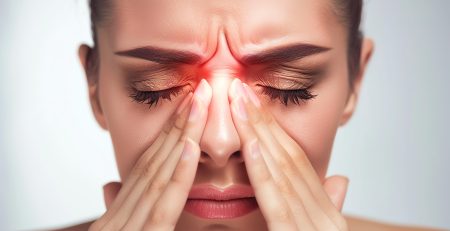What’s Causing Your Nasal Congestion at Work? 3 Common Office Triggers You Might Be Overlooking
Nasal congestion may seem like a small issue — easily overlooked, especially when there’s no accompanying fever or serious illness. But for working professionals who spend 8 to 10 hours a day in an office environment, this seemingly minor symptom can significantly affect concentration, productivity, and overall well-being throughout the day.
Most people associate nasal congestion with common colds or seasonal allergies. However, the reality is that many hidden triggers are lurking right inside your workplace. Indoor climate, air conditioning, dust, odors, and even overlooked daily habits can all contribute to nasal congestion in subtle ways. Understanding these underlying causes is the first step to managing the issue effectively.
Cause #1: Allergies to Indoor Air (Sick Building Syndrome)
Sick Building Syndrome refers to a condition in which individuals feel unwell or experience symptoms such as colds, coughing, or a runny nose while inside a particular building — symptoms that often improve quickly once they leave the space.
According to the U.S. Environmental Protection Agency (EPA), indoor air can be up to 100 times more polluted than outdoor air. If you notice your symptoms occur only in specific places like your office, school, or residential building, you may be experiencing Sick Building Syndrome. Common causes include dust buildup in HVAC systems, old carpets, mold in poorly ventilated rooms, or chemical residues from building materials.
Typical symptoms include nasal congestion, clear runny nose, itching inside the nose, and frequent sneezing — particularly in the morning or after spending long hours in air-conditioned rooms.
How to Relieve Symptoms:
- Regularly clean air conditioning units and carpets
- Use an air purifier equipped with a HEPA filter.
- If possible, open windows to allow air circulation for at least 10–15 minutes each day
Cause #2: Irritation from Scents and Chemicals
The smell of floor cleaners, air fresheners, cosmetics, or even food in the office may not cause an “allergic” reaction per se. However, they can still trigger nasal congestion — especially in people who are sensitive to strong scents or airborne particles.
While these substances may not lead to a direct allergic response, your body might react defensively by producing more mucus to block irritants from entering the respiratory system. This response can result in a stuffy nose, labored breathing, frequent sneezing, or an overall sense of discomfort while trying to work.
Cause #3: Office Equipment: A Hidden Source of Dust and Germs
Many people overlook everyday items like computers, curtains, or blinds as potential culprits behind their nasal congestion. In reality, these items are often dust traps that harbor allergens and pathogens.
Fine dust particles, fibers, and pollen can accumulate on power cords, printers, ventilation grilles, and cooling fans of office electronics. Over time, these contaminants build up — and each day you spend working at your desk, you’re likely inhaling them without even realizing it.
Regular cleaning and maintenance of office equipment is crucial. It helps minimize dust buildup and prevents allergens from circulating in your workspace, making your office environment healthier and safer. By keeping these areas clean, you can significantly reduce your risk of nasal congestion and dust-related allergies.
Though nasal congestion may seem trivial, ignoring it can lead to long-term health issues — especially if the root cause goes unidentified. Paying closer attention to your surroundings, including air quality, dust levels, odors, and the cleanliness of equipment, can make a significant difference.
For those seeking a safe and natural way to ease symptoms, Happy Noz Runny nose relief patch offers an effective alternative — no medication needed.
Happy Noz Anti Virus Formula
paired with a refreshing natural aroma.
Contains turmeric oil extract rich in antioxidants, which helps strengthen the immune system.
Safe for daily use – instantly relfresh.
“First stick, Quick Relief”

Sources :
- 6 Things That Cause Sick Building Syndrome : https://rtkenvironmental.com/health/sick-building-syndrome/
- The 5 Most Germ-Filled Places In Your Office—And How to Protect Yourself : https://time.com/5427242/bacteria-germs-office/
3.Stuffy nose, difficulty breathing : https://www.si.mahidol.ac.th/th/healthdetail.asp?aid=1214













